Financial Accounting Report
VerifiedAdded on 2020/12/09
|14
|3603
|479
Report
AI Summary
This report analyzes the financial accounting practices of Conga, a small toy retailer, demonstrating the application of key concepts like prudence and accrual. It includes the preparation of accounting records, financial statements, and a discussion on the significance of VAT in business operations.
Contribute Materials
Your contribution can guide someone’s learning journey. Share your
documents today.
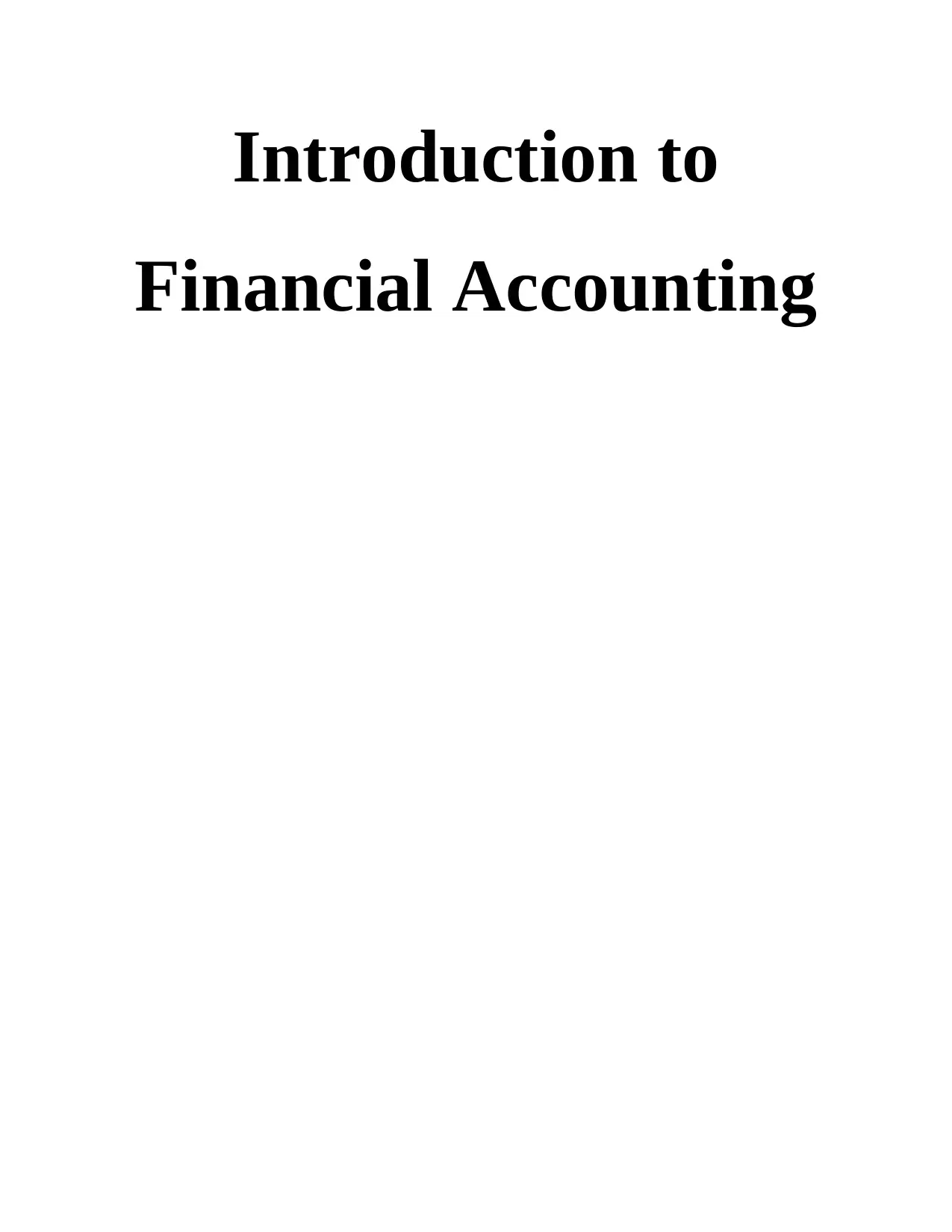
Introduction to
Financial Accounting
Financial Accounting
Secure Best Marks with AI Grader
Need help grading? Try our AI Grader for instant feedback on your assignments.
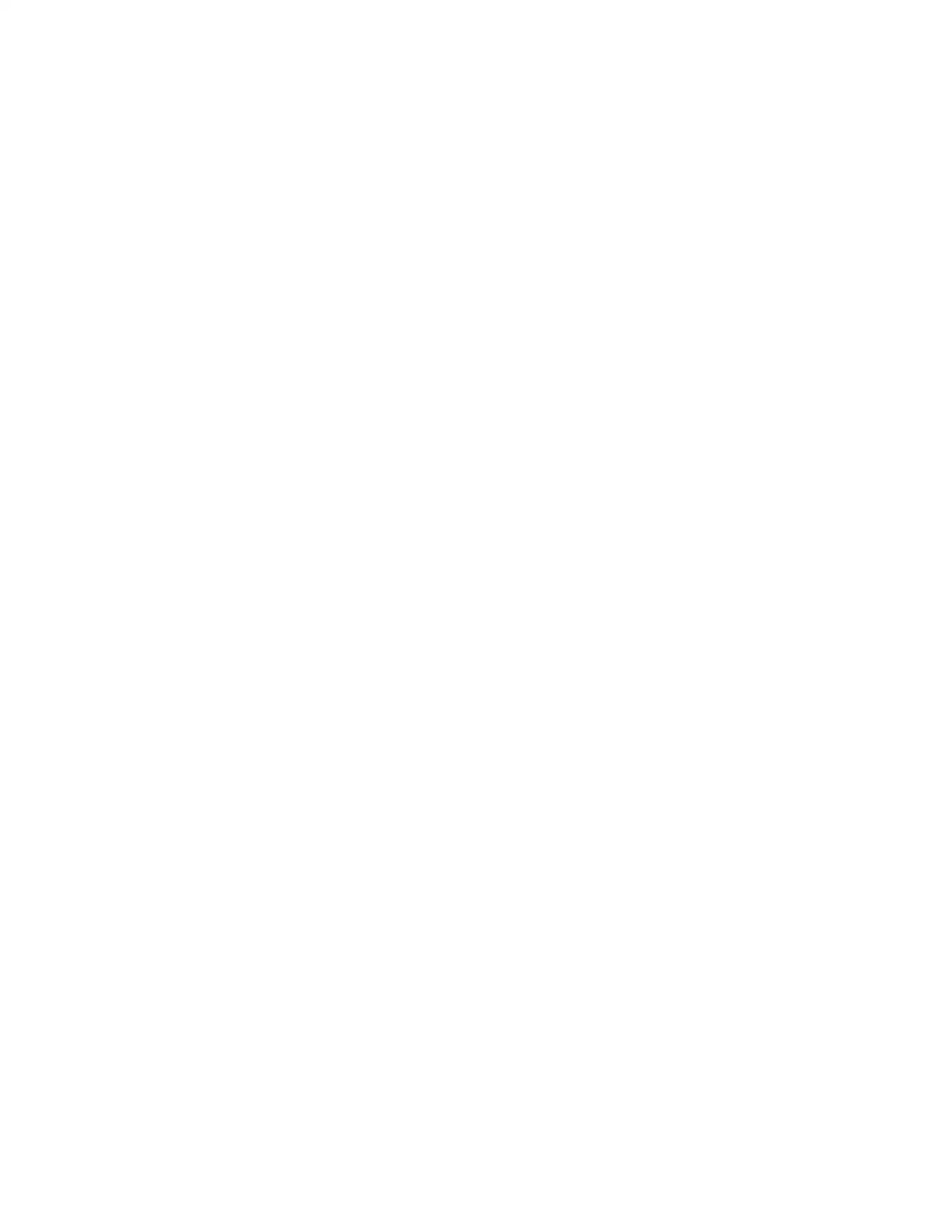
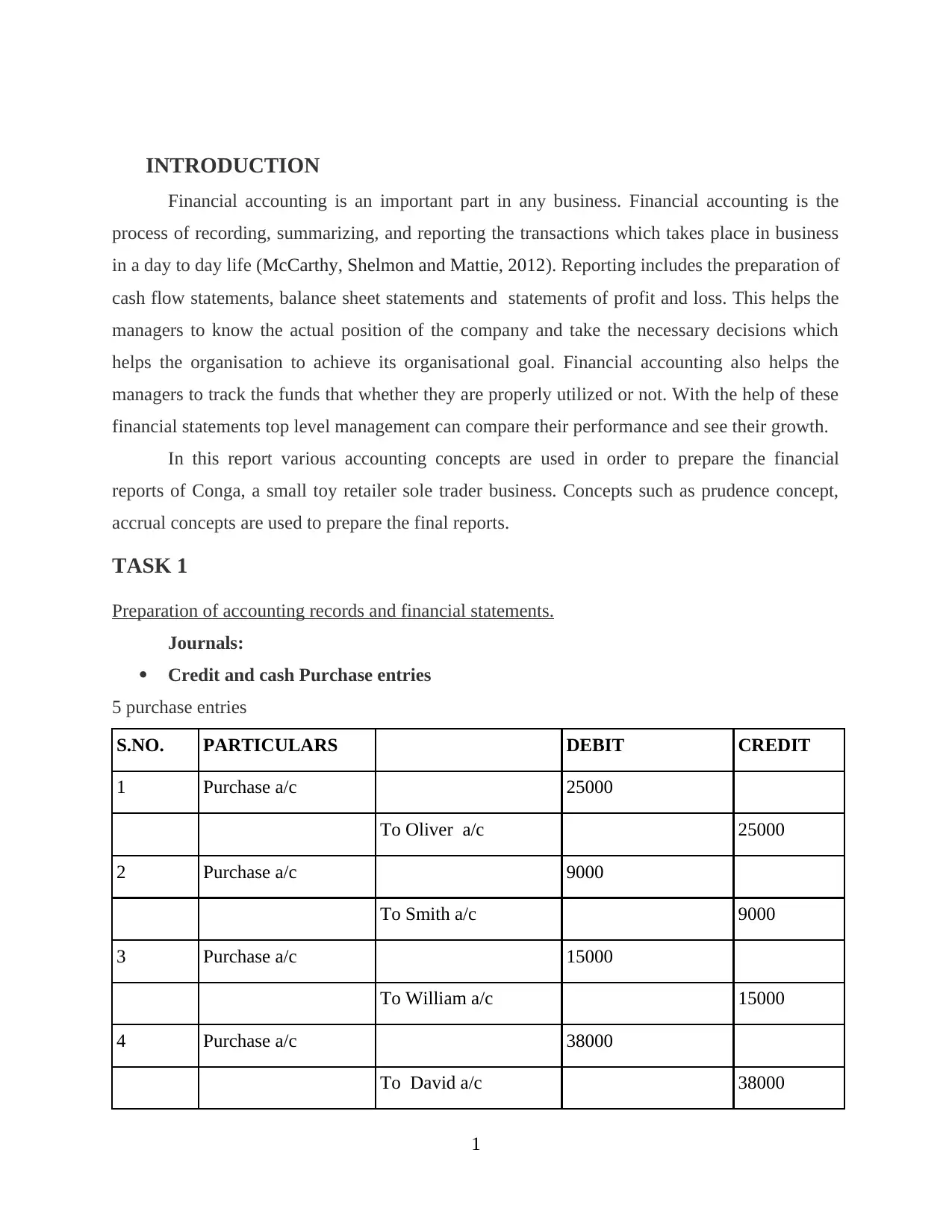
INTRODUCTION
Financial accounting is an important part in any business. Financial accounting is the
process of recording, summarizing, and reporting the transactions which takes place in business
in a day to day life (McCarthy, Shelmon and Mattie, 2012). Reporting includes the preparation of
cash flow statements, balance sheet statements and statements of profit and loss. This helps the
managers to know the actual position of the company and take the necessary decisions which
helps the organisation to achieve its organisational goal. Financial accounting also helps the
managers to track the funds that whether they are properly utilized or not. With the help of these
financial statements top level management can compare their performance and see their growth.
In this report various accounting concepts are used in order to prepare the financial
reports of Conga, a small toy retailer sole trader business. Concepts such as prudence concept,
accrual concepts are used to prepare the final reports.
TASK 1
Preparation of accounting records and financial statements.
Journals:
Credit and cash Purchase entries
5 purchase entries
S.NO. PARTICULARS DEBIT CREDIT
1 Purchase a/c 25000
To Oliver a/c 25000
2 Purchase a/c 9000
To Smith a/c 9000
3 Purchase a/c 15000
To William a/c 15000
4 Purchase a/c 38000
To David a/c 38000
1
Financial accounting is an important part in any business. Financial accounting is the
process of recording, summarizing, and reporting the transactions which takes place in business
in a day to day life (McCarthy, Shelmon and Mattie, 2012). Reporting includes the preparation of
cash flow statements, balance sheet statements and statements of profit and loss. This helps the
managers to know the actual position of the company and take the necessary decisions which
helps the organisation to achieve its organisational goal. Financial accounting also helps the
managers to track the funds that whether they are properly utilized or not. With the help of these
financial statements top level management can compare their performance and see their growth.
In this report various accounting concepts are used in order to prepare the financial
reports of Conga, a small toy retailer sole trader business. Concepts such as prudence concept,
accrual concepts are used to prepare the final reports.
TASK 1
Preparation of accounting records and financial statements.
Journals:
Credit and cash Purchase entries
5 purchase entries
S.NO. PARTICULARS DEBIT CREDIT
1 Purchase a/c 25000
To Oliver a/c 25000
2 Purchase a/c 9000
To Smith a/c 9000
3 Purchase a/c 15000
To William a/c 15000
4 Purchase a/c 38000
To David a/c 38000
1
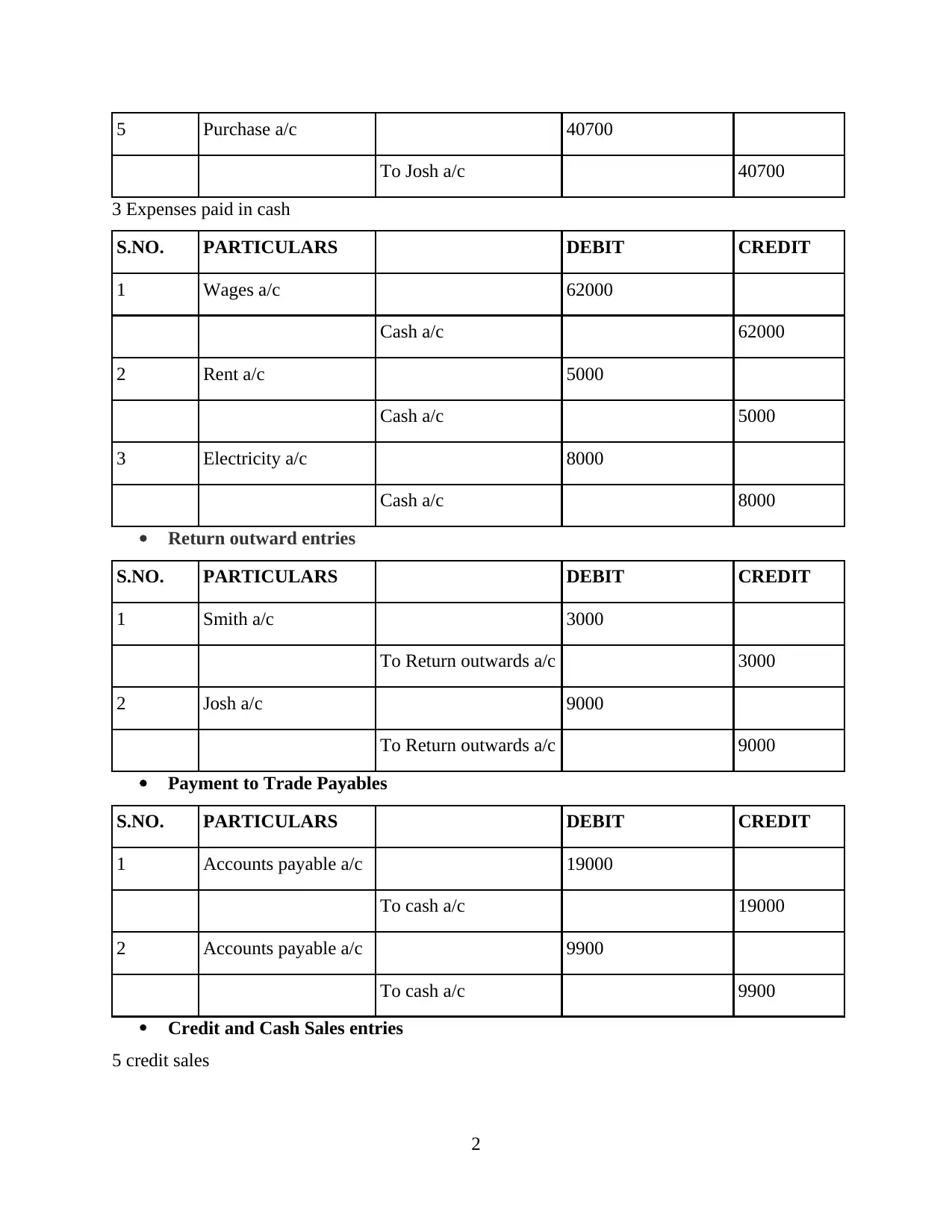
5 Purchase a/c 40700
To Josh a/c 40700
3 Expenses paid in cash
S.NO. PARTICULARS DEBIT CREDIT
1 Wages a/c 62000
Cash a/c 62000
2 Rent a/c 5000
Cash a/c 5000
3 Electricity a/c 8000
Cash a/c 8000
Return outward entries
S.NO. PARTICULARS DEBIT CREDIT
1 Smith a/c 3000
To Return outwards a/c 3000
2 Josh a/c 9000
To Return outwards a/c 9000
Payment to Trade Payables
S.NO. PARTICULARS DEBIT CREDIT
1 Accounts payable a/c 19000
To cash a/c 19000
2 Accounts payable a/c 9900
To cash a/c 9900
Credit and Cash Sales entries
5 credit sales
2
To Josh a/c 40700
3 Expenses paid in cash
S.NO. PARTICULARS DEBIT CREDIT
1 Wages a/c 62000
Cash a/c 62000
2 Rent a/c 5000
Cash a/c 5000
3 Electricity a/c 8000
Cash a/c 8000
Return outward entries
S.NO. PARTICULARS DEBIT CREDIT
1 Smith a/c 3000
To Return outwards a/c 3000
2 Josh a/c 9000
To Return outwards a/c 9000
Payment to Trade Payables
S.NO. PARTICULARS DEBIT CREDIT
1 Accounts payable a/c 19000
To cash a/c 19000
2 Accounts payable a/c 9900
To cash a/c 9900
Credit and Cash Sales entries
5 credit sales
2
Secure Best Marks with AI Grader
Need help grading? Try our AI Grader for instant feedback on your assignments.
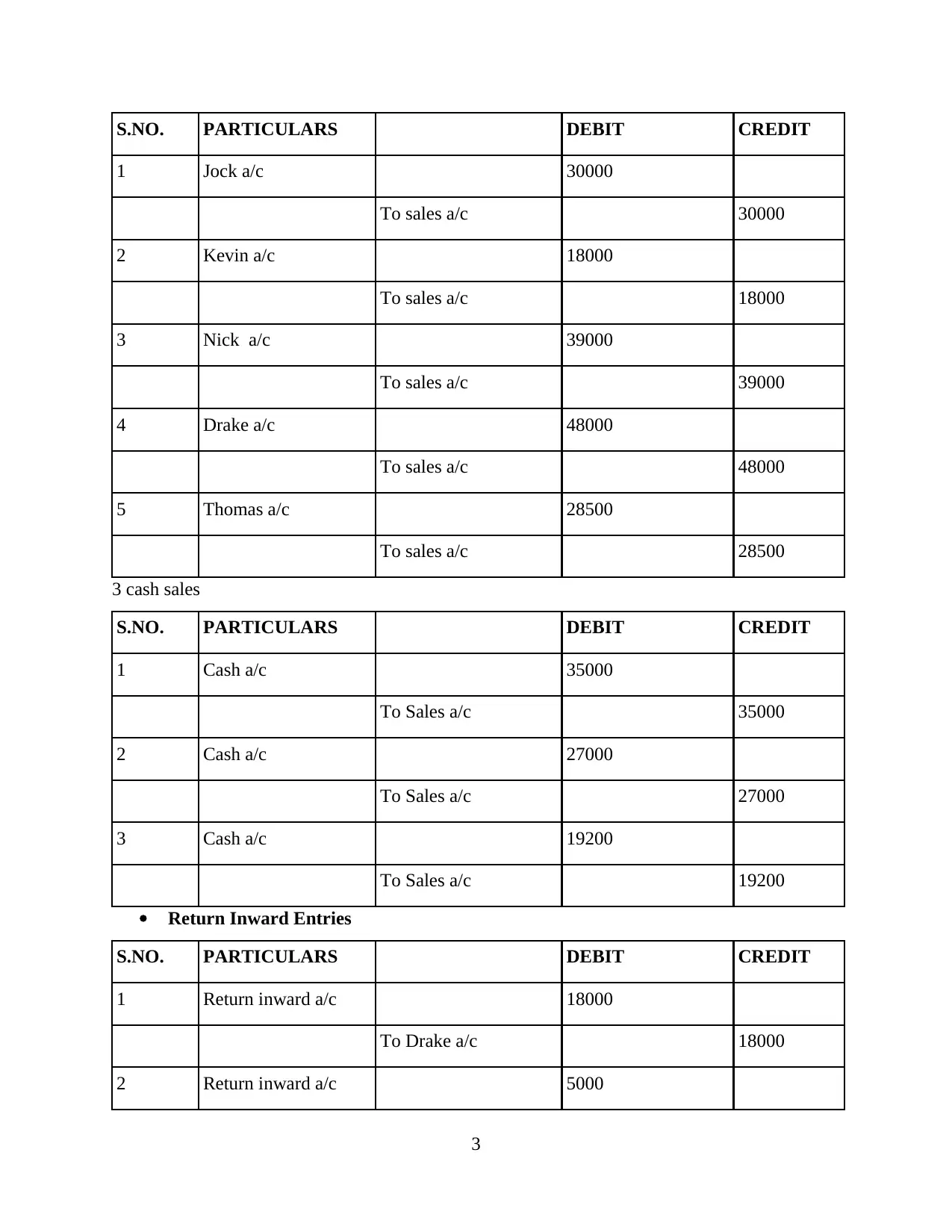
S.NO. PARTICULARS DEBIT CREDIT
1 Jock a/c 30000
To sales a/c 30000
2 Kevin a/c 18000
To sales a/c 18000
3 Nick a/c 39000
To sales a/c 39000
4 Drake a/c 48000
To sales a/c 48000
5 Thomas a/c 28500
To sales a/c 28500
3 cash sales
S.NO. PARTICULARS DEBIT CREDIT
1 Cash a/c 35000
To Sales a/c 35000
2 Cash a/c 27000
To Sales a/c 27000
3 Cash a/c 19200
To Sales a/c 19200
Return Inward Entries
S.NO. PARTICULARS DEBIT CREDIT
1 Return inward a/c 18000
To Drake a/c 18000
2 Return inward a/c 5000
3
1 Jock a/c 30000
To sales a/c 30000
2 Kevin a/c 18000
To sales a/c 18000
3 Nick a/c 39000
To sales a/c 39000
4 Drake a/c 48000
To sales a/c 48000
5 Thomas a/c 28500
To sales a/c 28500
3 cash sales
S.NO. PARTICULARS DEBIT CREDIT
1 Cash a/c 35000
To Sales a/c 35000
2 Cash a/c 27000
To Sales a/c 27000
3 Cash a/c 19200
To Sales a/c 19200
Return Inward Entries
S.NO. PARTICULARS DEBIT CREDIT
1 Return inward a/c 18000
To Drake a/c 18000
2 Return inward a/c 5000
3
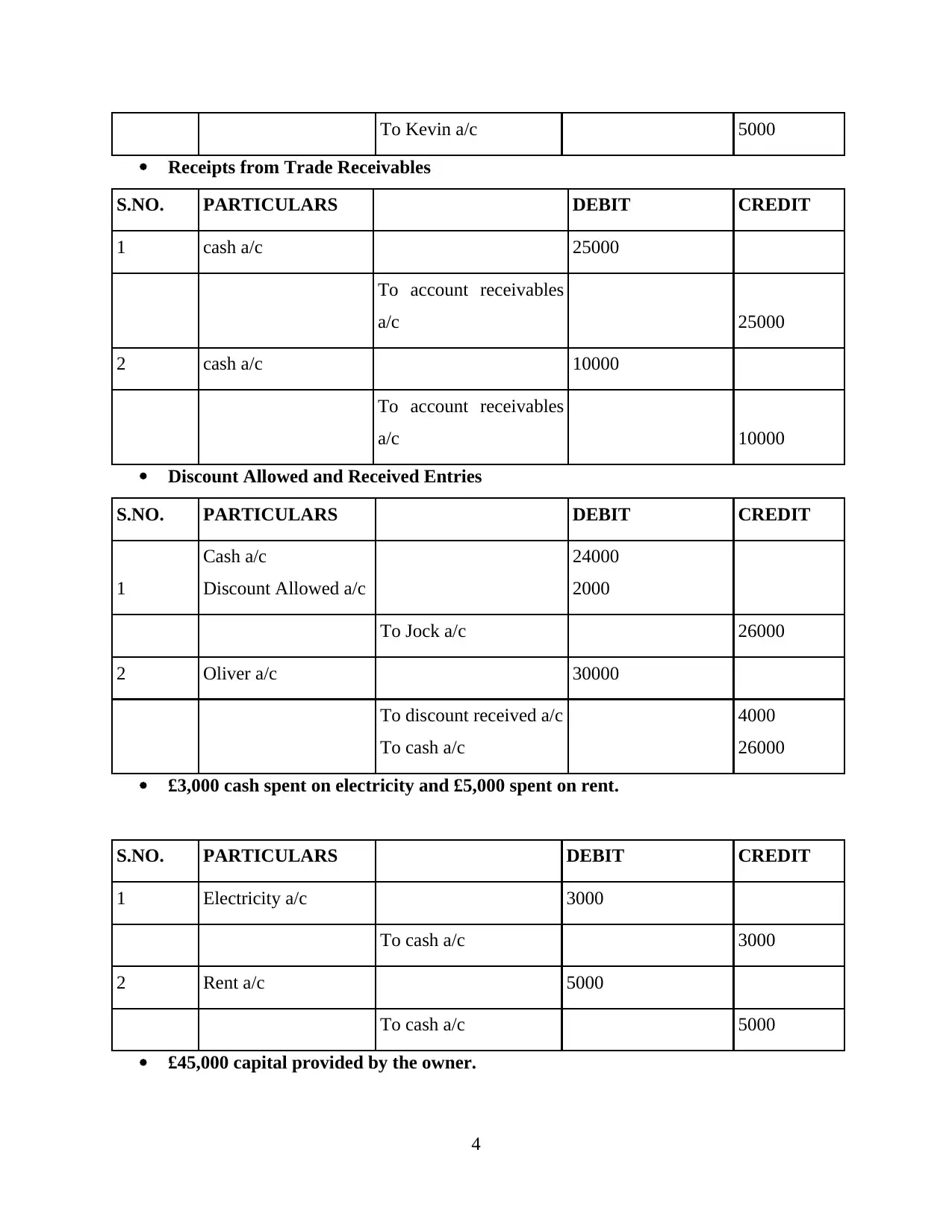
To Kevin a/c 5000
Receipts from Trade Receivables
S.NO. PARTICULARS DEBIT CREDIT
1 cash a/c 25000
To account receivables
a/c 25000
2 cash a/c 10000
To account receivables
a/c 10000
Discount Allowed and Received Entries
S.NO. PARTICULARS DEBIT CREDIT
1
Cash a/c
Discount Allowed a/c
24000
2000
To Jock a/c 26000
2 Oliver a/c 30000
To discount received a/c
To cash a/c
4000
26000
£3,000 cash spent on electricity and £5,000 spent on rent.
S.NO. PARTICULARS DEBIT CREDIT
1 Electricity a/c 3000
To cash a/c 3000
2 Rent a/c 5000
To cash a/c 5000
£45,000 capital provided by the owner.
4
Receipts from Trade Receivables
S.NO. PARTICULARS DEBIT CREDIT
1 cash a/c 25000
To account receivables
a/c 25000
2 cash a/c 10000
To account receivables
a/c 10000
Discount Allowed and Received Entries
S.NO. PARTICULARS DEBIT CREDIT
1
Cash a/c
Discount Allowed a/c
24000
2000
To Jock a/c 26000
2 Oliver a/c 30000
To discount received a/c
To cash a/c
4000
26000
£3,000 cash spent on electricity and £5,000 spent on rent.
S.NO. PARTICULARS DEBIT CREDIT
1 Electricity a/c 3000
To cash a/c 3000
2 Rent a/c 5000
To cash a/c 5000
£45,000 capital provided by the owner.
4
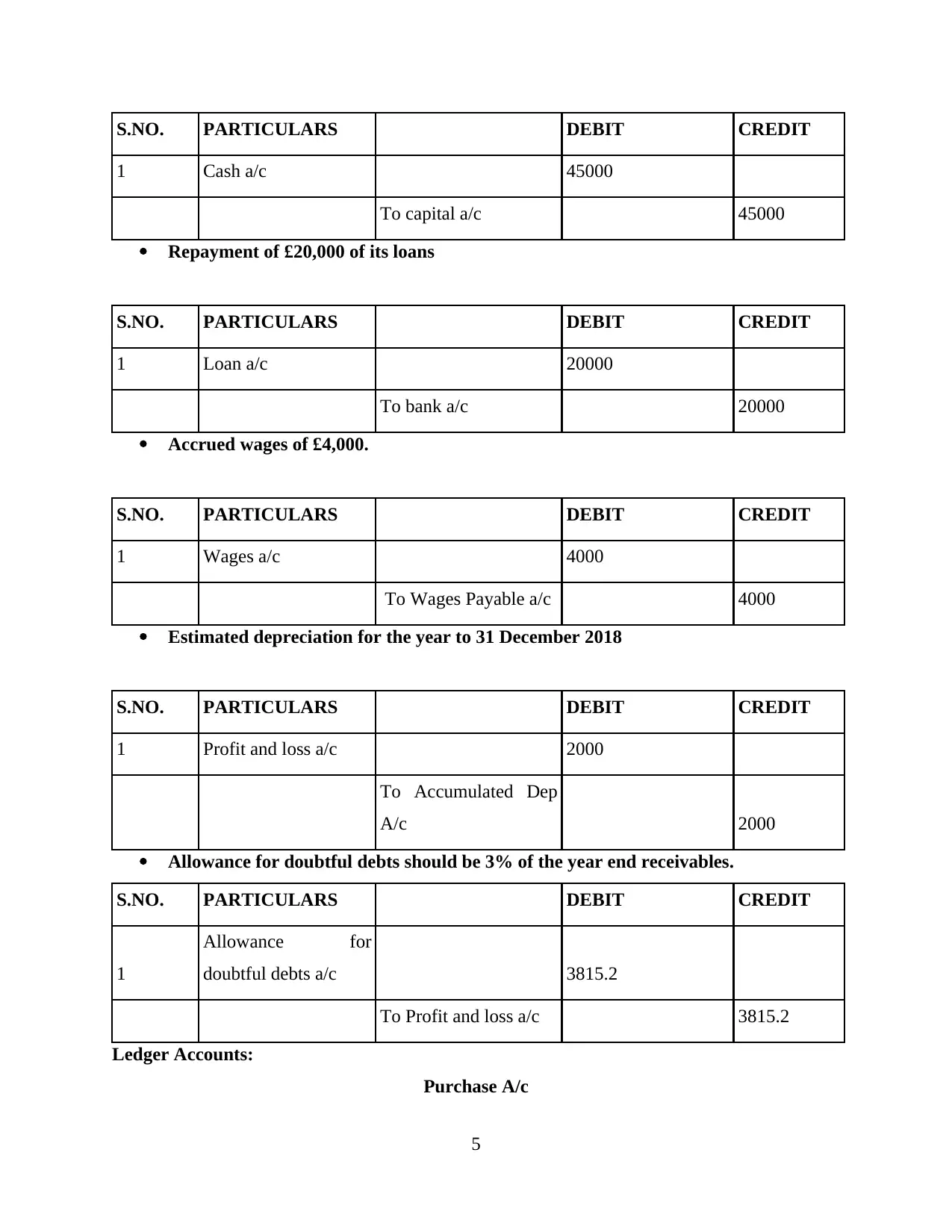
S.NO. PARTICULARS DEBIT CREDIT
1 Cash a/c 45000
To capital a/c 45000
Repayment of £20,000 of its loans
S.NO. PARTICULARS DEBIT CREDIT
1 Loan a/c 20000
To bank a/c 20000
Accrued wages of £4,000.
S.NO. PARTICULARS DEBIT CREDIT
1 Wages a/c 4000
To Wages Payable a/c 4000
Estimated depreciation for the year to 31 December 2018
S.NO. PARTICULARS DEBIT CREDIT
1 Profit and loss a/c 2000
To Accumulated Dep
A/c 2000
Allowance for doubtful debts should be 3% of the year end receivables.
S.NO. PARTICULARS DEBIT CREDIT
1
Allowance for
doubtful debts a/c 3815.2
To Profit and loss a/c 3815.2
Ledger Accounts:
Purchase A/c
5
1 Cash a/c 45000
To capital a/c 45000
Repayment of £20,000 of its loans
S.NO. PARTICULARS DEBIT CREDIT
1 Loan a/c 20000
To bank a/c 20000
Accrued wages of £4,000.
S.NO. PARTICULARS DEBIT CREDIT
1 Wages a/c 4000
To Wages Payable a/c 4000
Estimated depreciation for the year to 31 December 2018
S.NO. PARTICULARS DEBIT CREDIT
1 Profit and loss a/c 2000
To Accumulated Dep
A/c 2000
Allowance for doubtful debts should be 3% of the year end receivables.
S.NO. PARTICULARS DEBIT CREDIT
1
Allowance for
doubtful debts a/c 3815.2
To Profit and loss a/c 3815.2
Ledger Accounts:
Purchase A/c
5
Paraphrase This Document
Need a fresh take? Get an instant paraphrase of this document with our AI Paraphraser
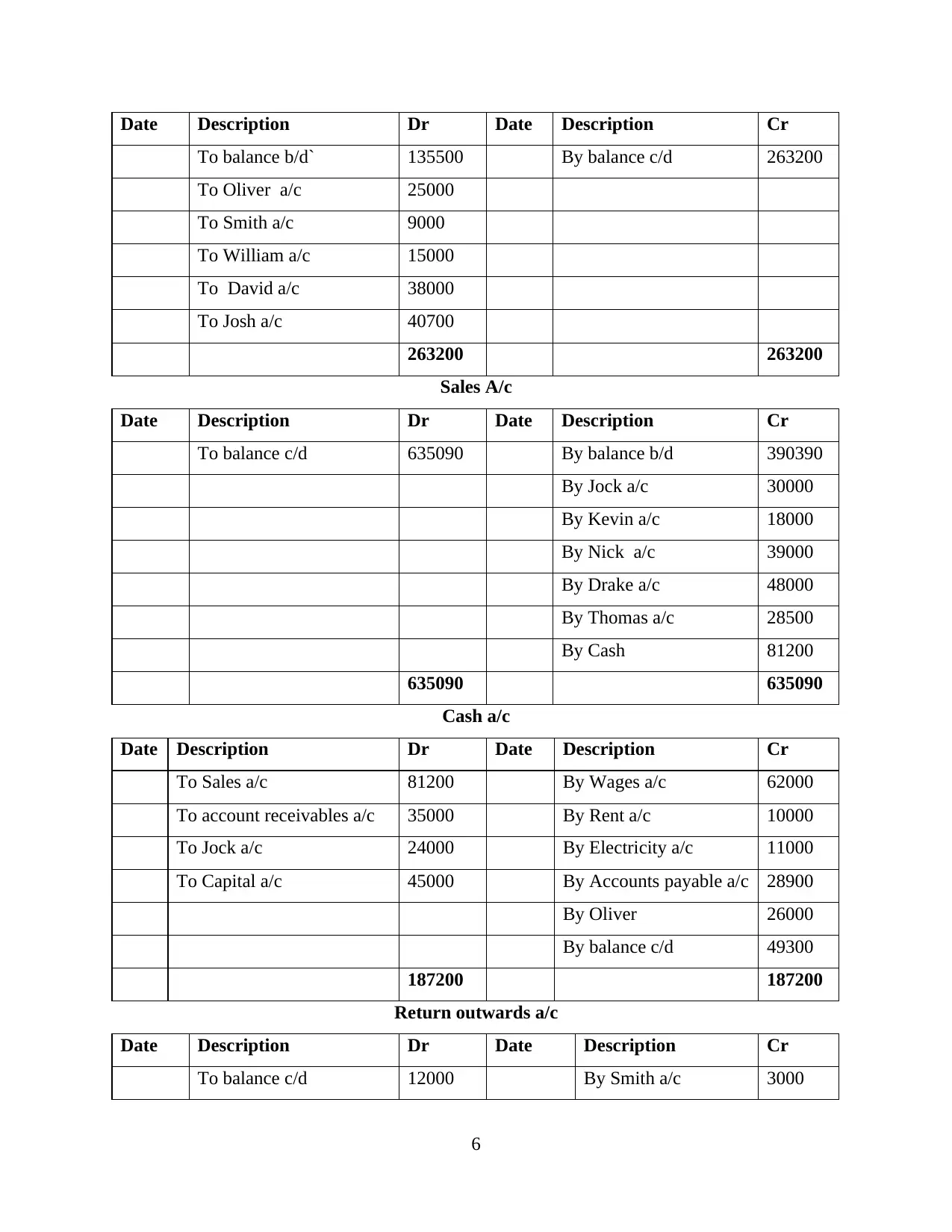
Date Description Dr Date Description Cr
To balance b/d` 135500 By balance c/d 263200
To Oliver a/c 25000
To Smith a/c 9000
To William a/c 15000
To David a/c 38000
To Josh a/c 40700
263200 263200
Sales A/c
Date Description Dr Date Description Cr
To balance c/d 635090 By balance b/d 390390
By Jock a/c 30000
By Kevin a/c 18000
By Nick a/c 39000
By Drake a/c 48000
By Thomas a/c 28500
By Cash 81200
635090 635090
Cash a/c
Date Description Dr Date Description Cr
To Sales a/c 81200 By Wages a/c 62000
To account receivables a/c 35000 By Rent a/c 10000
To Jock a/c 24000 By Electricity a/c 11000
To Capital a/c 45000 By Accounts payable a/c 28900
By Oliver 26000
By balance c/d 49300
187200 187200
Return outwards a/c
Date Description Dr Date Description Cr
To balance c/d 12000 By Smith a/c 3000
6
To balance b/d` 135500 By balance c/d 263200
To Oliver a/c 25000
To Smith a/c 9000
To William a/c 15000
To David a/c 38000
To Josh a/c 40700
263200 263200
Sales A/c
Date Description Dr Date Description Cr
To balance c/d 635090 By balance b/d 390390
By Jock a/c 30000
By Kevin a/c 18000
By Nick a/c 39000
By Drake a/c 48000
By Thomas a/c 28500
By Cash 81200
635090 635090
Cash a/c
Date Description Dr Date Description Cr
To Sales a/c 81200 By Wages a/c 62000
To account receivables a/c 35000 By Rent a/c 10000
To Jock a/c 24000 By Electricity a/c 11000
To Capital a/c 45000 By Accounts payable a/c 28900
By Oliver 26000
By balance c/d 49300
187200 187200
Return outwards a/c
Date Description Dr Date Description Cr
To balance c/d 12000 By Smith a/c 3000
6
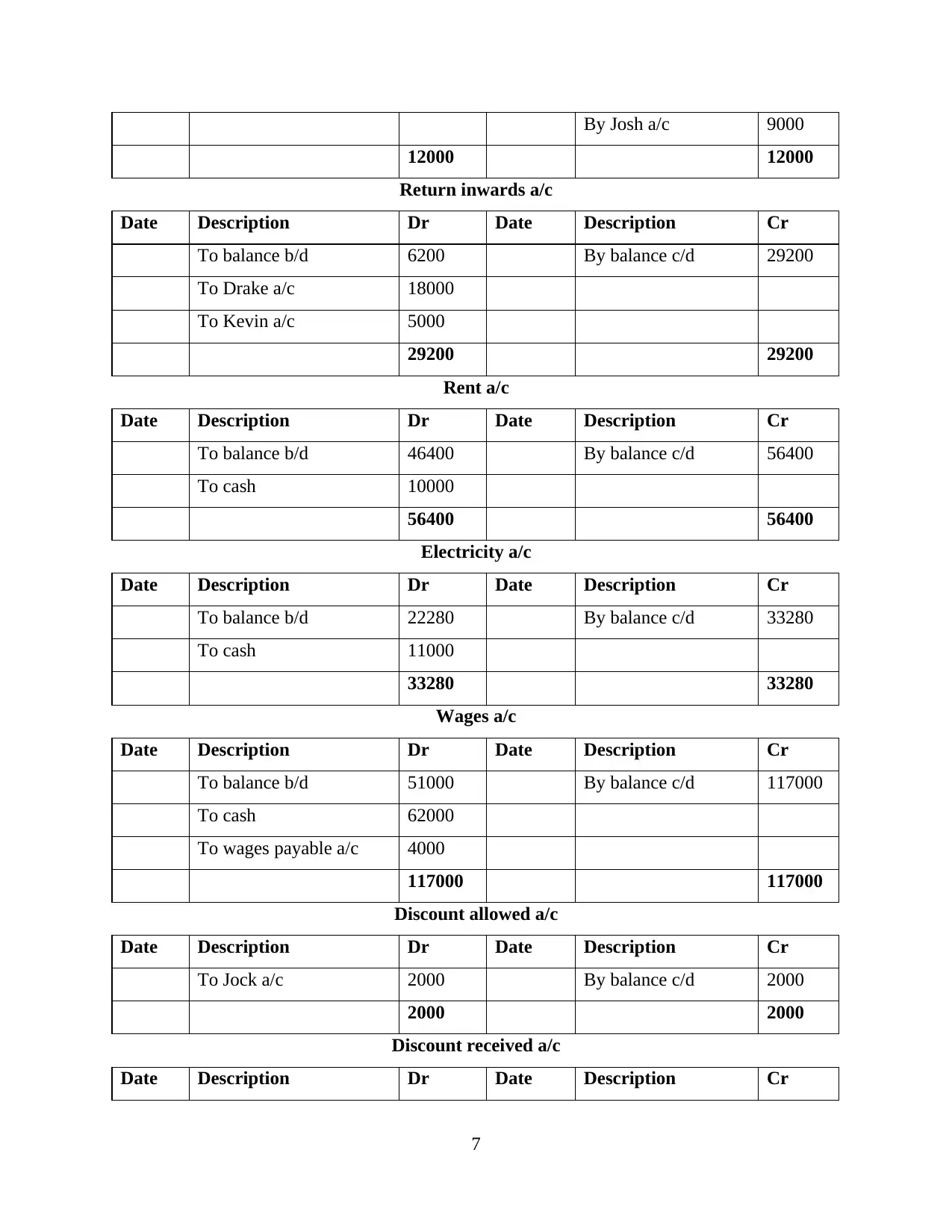
By Josh a/c 9000
12000 12000
Return inwards a/c
Date Description Dr Date Description Cr
To balance b/d 6200 By balance c/d 29200
To Drake a/c 18000
To Kevin a/c 5000
29200 29200
Rent a/c
Date Description Dr Date Description Cr
To balance b/d 46400 By balance c/d 56400
To cash 10000
56400 56400
Electricity a/c
Date Description Dr Date Description Cr
To balance b/d 22280 By balance c/d 33280
To cash 11000
33280 33280
Wages a/c
Date Description Dr Date Description Cr
To balance b/d 51000 By balance c/d 117000
To cash 62000
To wages payable a/c 4000
117000 117000
Discount allowed a/c
Date Description Dr Date Description Cr
To Jock a/c 2000 By balance c/d 2000
2000 2000
Discount received a/c
Date Description Dr Date Description Cr
7
12000 12000
Return inwards a/c
Date Description Dr Date Description Cr
To balance b/d 6200 By balance c/d 29200
To Drake a/c 18000
To Kevin a/c 5000
29200 29200
Rent a/c
Date Description Dr Date Description Cr
To balance b/d 46400 By balance c/d 56400
To cash 10000
56400 56400
Electricity a/c
Date Description Dr Date Description Cr
To balance b/d 22280 By balance c/d 33280
To cash 11000
33280 33280
Wages a/c
Date Description Dr Date Description Cr
To balance b/d 51000 By balance c/d 117000
To cash 62000
To wages payable a/c 4000
117000 117000
Discount allowed a/c
Date Description Dr Date Description Cr
To Jock a/c 2000 By balance c/d 2000
2000 2000
Discount received a/c
Date Description Dr Date Description Cr
7

To balance c/d 4000 By Oliver a/c 4000
4000 4000
Capital a/c
Date Description Dr Date Description Cr
To balance c/d 195000 By balance b/d 150000
By cash 45000
195000 195000
Accumulated Depreciation a/c
Date Description Dr Date Description Cr
To balance c/d 48000 By balance b/d 46000
By profit and loss a/c 2000
48000 48000
Allowance for Bad debts a/c
Date Description Dr Date Description Cr
To profit and loss a/c 3815.2 By balance b/d 7300
To balance b/d 3484.8
7300 7300
Accounts receivables A/c
Date Description Dr Date Description Cr
To balance b/d 36660 By Return Inwards a/c 23000
To Sales a/c 163500 By Cash a/c 61000
By balance c/d 116160
200160 200160
Accounts payables A/c
Date Description Dr Date Description Cr
To Return outward a/c 12000 By balance b/d 30900
To Cash a/c 28900 By Purchase a/c 127700
To balance c/d 117700
158600 158600
Bank A/c
8
4000 4000
Capital a/c
Date Description Dr Date Description Cr
To balance c/d 195000 By balance b/d 150000
By cash 45000
195000 195000
Accumulated Depreciation a/c
Date Description Dr Date Description Cr
To balance c/d 48000 By balance b/d 46000
By profit and loss a/c 2000
48000 48000
Allowance for Bad debts a/c
Date Description Dr Date Description Cr
To profit and loss a/c 3815.2 By balance b/d 7300
To balance b/d 3484.8
7300 7300
Accounts receivables A/c
Date Description Dr Date Description Cr
To balance b/d 36660 By Return Inwards a/c 23000
To Sales a/c 163500 By Cash a/c 61000
By balance c/d 116160
200160 200160
Accounts payables A/c
Date Description Dr Date Description Cr
To Return outward a/c 12000 By balance b/d 30900
To Cash a/c 28900 By Purchase a/c 127700
To balance c/d 117700
158600 158600
Bank A/c
8
Secure Best Marks with AI Grader
Need help grading? Try our AI Grader for instant feedback on your assignments.

Date Description Dr Date Description Cr
To balance b/d 15410 By Loan 20000
To balance c/d 4590
20000 20000
Loan A/c
Date Description Dr Date Description Cr
To bank 20000 By balance b/d 60000
To balance c/d 40000
60000 60000
Trail Balance:
Conga Trial Balance at 31 December 2018:
Ledger Account Dr Cr
Purchase A/c 263200
Sales A/c 635090
Cash a/c 49300
Return outwards a/c 12000
Return inwards a/c 29200
Rent a/c 56400
Electricity a/c 33280
Wages a/c 117000
Discount allowed a/c 2000
Discount received a/c 4000
Capital a/c 195000
Accumulated Depreciation a/c 48000
Allowance for Bad debts a/c 3484.8
Accounts receivables a/c 116160
Accounts payables a/c 117700
Bank a/c 4590
Equipment 280000
Loan a/c 40000
9
To balance b/d 15410 By Loan 20000
To balance c/d 4590
20000 20000
Loan A/c
Date Description Dr Date Description Cr
To bank 20000 By balance b/d 60000
To balance c/d 40000
60000 60000
Trail Balance:
Conga Trial Balance at 31 December 2018:
Ledger Account Dr Cr
Purchase A/c 263200
Sales A/c 635090
Cash a/c 49300
Return outwards a/c 12000
Return inwards a/c 29200
Rent a/c 56400
Electricity a/c 33280
Wages a/c 117000
Discount allowed a/c 2000
Discount received a/c 4000
Capital a/c 195000
Accumulated Depreciation a/c 48000
Allowance for Bad debts a/c 3484.8
Accounts receivables a/c 116160
Accounts payables a/c 117700
Bank a/c 4590
Equipment 280000
Loan a/c 40000
9

Inventory 40000
Suspense a/c 73324.8
1059864.8 1059864.8
Income Statement:
Conga Income Statement for the year ending 31 December 2018
Particular Amount Amount
Sales 635090
Less: Sales Return -29200
605890
Add: closing Stock 40000 645890
Allowance for Bad debts 3815.2
Discount Received 4000
Net income 653705.2
Purchase
Less: Purchase return
263200
(12000)
Net purchases 251200
Wages 117000
Rent a/c 56400
Electricity a/c 33280
Opening stock 60140
Accumulated Depreciation 2000
Discount Allowed 2000
Net expenses 522020
Profit Before interest and Tax 131685.2
Less: Interest and Tax nil
Net Profit After Tax 131685.2
Balance Sheet:
Conga Statement of Financial Position at 31 December 2018.
Particular Amount Amount
Equity and shareholders fund.
10
Suspense a/c 73324.8
1059864.8 1059864.8
Income Statement:
Conga Income Statement for the year ending 31 December 2018
Particular Amount Amount
Sales 635090
Less: Sales Return -29200
605890
Add: closing Stock 40000 645890
Allowance for Bad debts 3815.2
Discount Received 4000
Net income 653705.2
Purchase
Less: Purchase return
263200
(12000)
Net purchases 251200
Wages 117000
Rent a/c 56400
Electricity a/c 33280
Opening stock 60140
Accumulated Depreciation 2000
Discount Allowed 2000
Net expenses 522020
Profit Before interest and Tax 131685.2
Less: Interest and Tax nil
Net Profit After Tax 131685.2
Balance Sheet:
Conga Statement of Financial Position at 31 December 2018.
Particular Amount Amount
Equity and shareholders fund.
10

Capital 195000
Non current Liabilities
Loan 40000
Current liabilities
Bank Over draft 4590
Accounts Payable 117700
Suspense account 80170
Total Liabilities 437460
Assets
Fixed Assets
Equipment
less: Accumulated depreciation
280000
(48000) 232000
Current assets
Cash at Hand 49300
Inventory 40000
Accounts receivables 116160
Total Assets 437460
TASK 2
There are some rule which are to be followed in the accounting in order to generate the
financial statements of the company (McLaney and Atrill, 2014). These rules are followed
globally, financial statements are generated within the guidelines of the rules given by the GAAP
(Generally Accepted Accounting Principles). Mainly there are four rules Prudence, Consistency,
Accruals and Full Disclosure which is necessary for every company to follow in order to prepare
the financial statements and to check their actual position. Following are some rules which are
discussed as:
Prudence Concept: Prudence concept states that the amount of revenue should not be
recorded by the company at overestimated value (Modell, 2014.). Prudence concept says that the
revenue should not be recorded in the book if it is assumed to be earned, revenue should only be
recorded when it is actually earned and the expenses and the losses should be recorded even if it
is not sure to incurred. According to this concept the company should record the assets and the
11
Non current Liabilities
Loan 40000
Current liabilities
Bank Over draft 4590
Accounts Payable 117700
Suspense account 80170
Total Liabilities 437460
Assets
Fixed Assets
Equipment
less: Accumulated depreciation
280000
(48000) 232000
Current assets
Cash at Hand 49300
Inventory 40000
Accounts receivables 116160
Total Assets 437460
TASK 2
There are some rule which are to be followed in the accounting in order to generate the
financial statements of the company (McLaney and Atrill, 2014). These rules are followed
globally, financial statements are generated within the guidelines of the rules given by the GAAP
(Generally Accepted Accounting Principles). Mainly there are four rules Prudence, Consistency,
Accruals and Full Disclosure which is necessary for every company to follow in order to prepare
the financial statements and to check their actual position. Following are some rules which are
discussed as:
Prudence Concept: Prudence concept states that the amount of revenue should not be
recorded by the company at overestimated value (Modell, 2014.). Prudence concept says that the
revenue should not be recorded in the book if it is assumed to be earned, revenue should only be
recorded when it is actually earned and the expenses and the losses should be recorded even if it
is not sure to incurred. According to this concept the company should record the assets and the
11
Paraphrase This Document
Need a fresh take? Get an instant paraphrase of this document with our AI Paraphraser
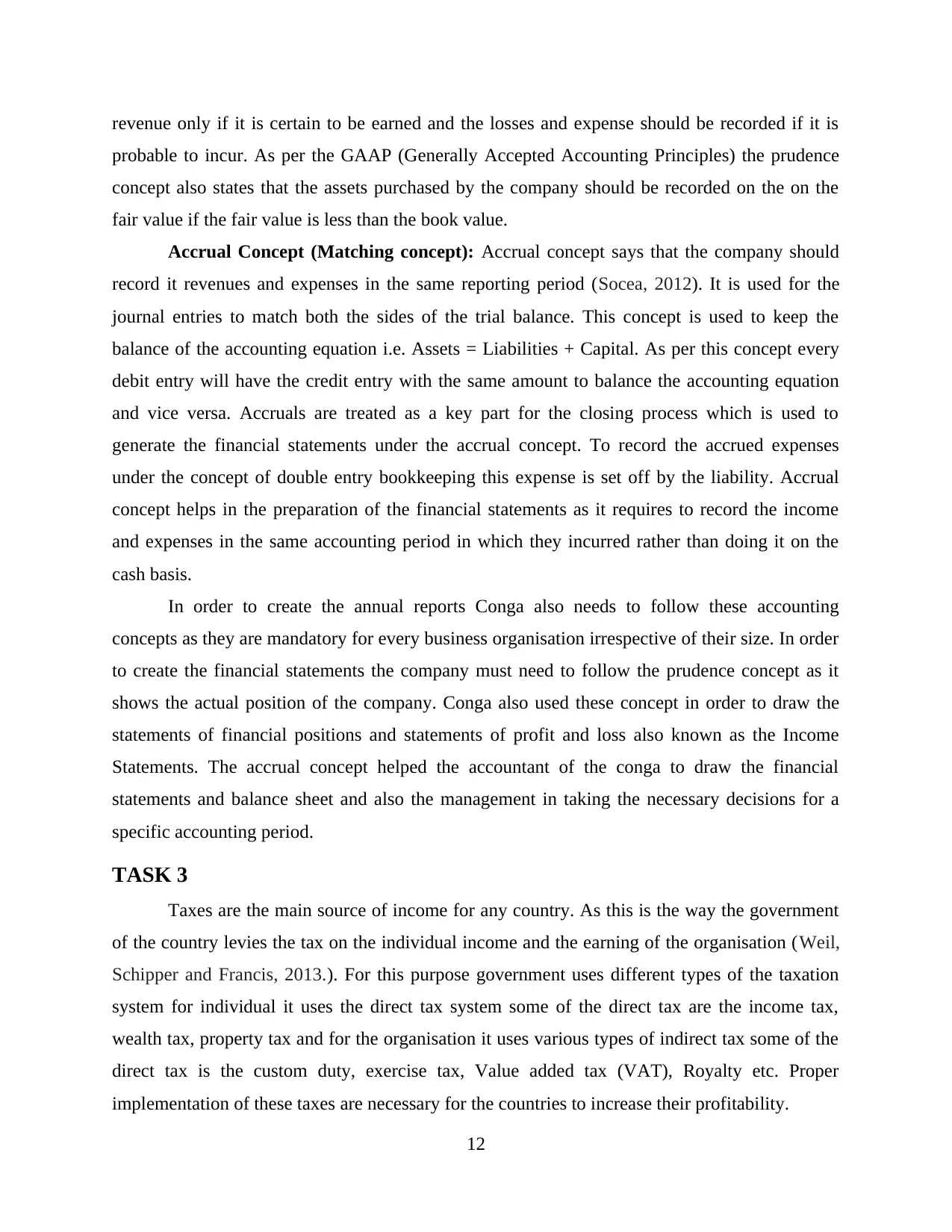
revenue only if it is certain to be earned and the losses and expense should be recorded if it is
probable to incur. As per the GAAP (Generally Accepted Accounting Principles) the prudence
concept also states that the assets purchased by the company should be recorded on the on the
fair value if the fair value is less than the book value.
Accrual Concept (Matching concept): Accrual concept says that the company should
record it revenues and expenses in the same reporting period (Socea, 2012). It is used for the
journal entries to match both the sides of the trial balance. This concept is used to keep the
balance of the accounting equation i.e. Assets = Liabilities + Capital. As per this concept every
debit entry will have the credit entry with the same amount to balance the accounting equation
and vice versa. Accruals are treated as a key part for the closing process which is used to
generate the financial statements under the accrual concept. To record the accrued expenses
under the concept of double entry bookkeeping this expense is set off by the liability. Accrual
concept helps in the preparation of the financial statements as it requires to record the income
and expenses in the same accounting period in which they incurred rather than doing it on the
cash basis.
In order to create the annual reports Conga also needs to follow these accounting
concepts as they are mandatory for every business organisation irrespective of their size. In order
to create the financial statements the company must need to follow the prudence concept as it
shows the actual position of the company. Conga also used these concept in order to draw the
statements of financial positions and statements of profit and loss also known as the Income
Statements. The accrual concept helped the accountant of the conga to draw the financial
statements and balance sheet and also the management in taking the necessary decisions for a
specific accounting period.
TASK 3
Taxes are the main source of income for any country. As this is the way the government
of the country levies the tax on the individual income and the earning of the organisation (Weil,
Schipper and Francis, 2013.). For this purpose government uses different types of the taxation
system for individual it uses the direct tax system some of the direct tax are the income tax,
wealth tax, property tax and for the organisation it uses various types of indirect tax some of the
direct tax is the custom duty, exercise tax, Value added tax (VAT), Royalty etc. Proper
implementation of these taxes are necessary for the countries to increase their profitability.
12
probable to incur. As per the GAAP (Generally Accepted Accounting Principles) the prudence
concept also states that the assets purchased by the company should be recorded on the on the
fair value if the fair value is less than the book value.
Accrual Concept (Matching concept): Accrual concept says that the company should
record it revenues and expenses in the same reporting period (Socea, 2012). It is used for the
journal entries to match both the sides of the trial balance. This concept is used to keep the
balance of the accounting equation i.e. Assets = Liabilities + Capital. As per this concept every
debit entry will have the credit entry with the same amount to balance the accounting equation
and vice versa. Accruals are treated as a key part for the closing process which is used to
generate the financial statements under the accrual concept. To record the accrued expenses
under the concept of double entry bookkeeping this expense is set off by the liability. Accrual
concept helps in the preparation of the financial statements as it requires to record the income
and expenses in the same accounting period in which they incurred rather than doing it on the
cash basis.
In order to create the annual reports Conga also needs to follow these accounting
concepts as they are mandatory for every business organisation irrespective of their size. In order
to create the financial statements the company must need to follow the prudence concept as it
shows the actual position of the company. Conga also used these concept in order to draw the
statements of financial positions and statements of profit and loss also known as the Income
Statements. The accrual concept helped the accountant of the conga to draw the financial
statements and balance sheet and also the management in taking the necessary decisions for a
specific accounting period.
TASK 3
Taxes are the main source of income for any country. As this is the way the government
of the country levies the tax on the individual income and the earning of the organisation (Weil,
Schipper and Francis, 2013.). For this purpose government uses different types of the taxation
system for individual it uses the direct tax system some of the direct tax are the income tax,
wealth tax, property tax and for the organisation it uses various types of indirect tax some of the
direct tax is the custom duty, exercise tax, Value added tax (VAT), Royalty etc. Proper
implementation of these taxes are necessary for the countries to increase their profitability.
12
1 out of 14
Related Documents
Your All-in-One AI-Powered Toolkit for Academic Success.
+13062052269
info@desklib.com
Available 24*7 on WhatsApp / Email
![[object Object]](/_next/static/media/star-bottom.7253800d.svg)
Unlock your academic potential
© 2024 | Zucol Services PVT LTD | All rights reserved.





